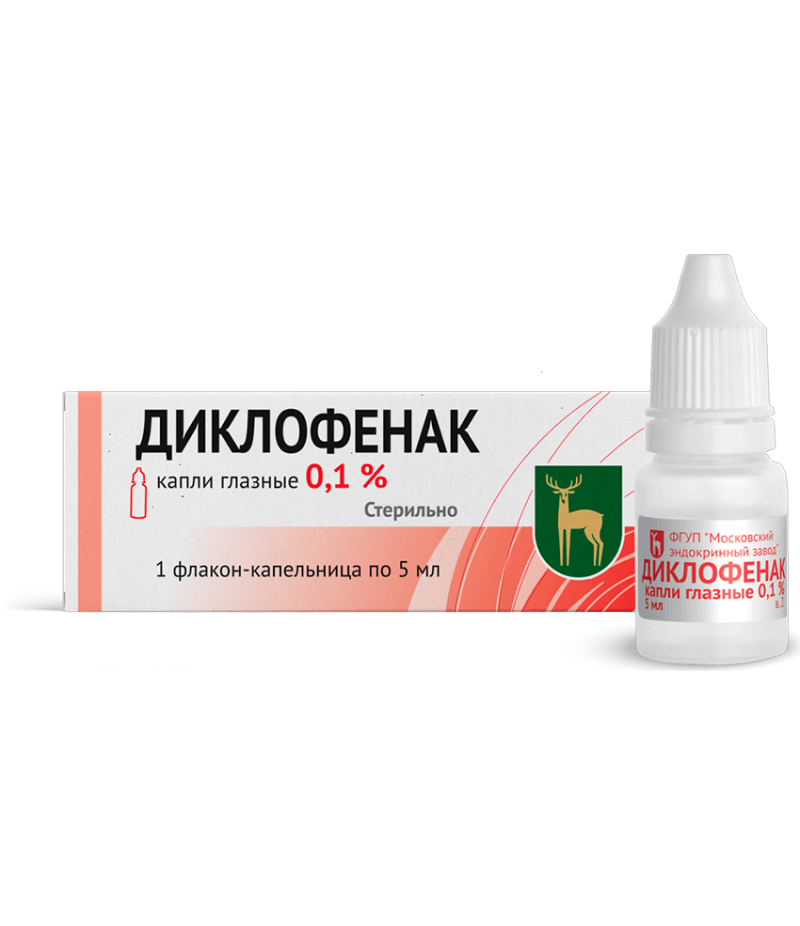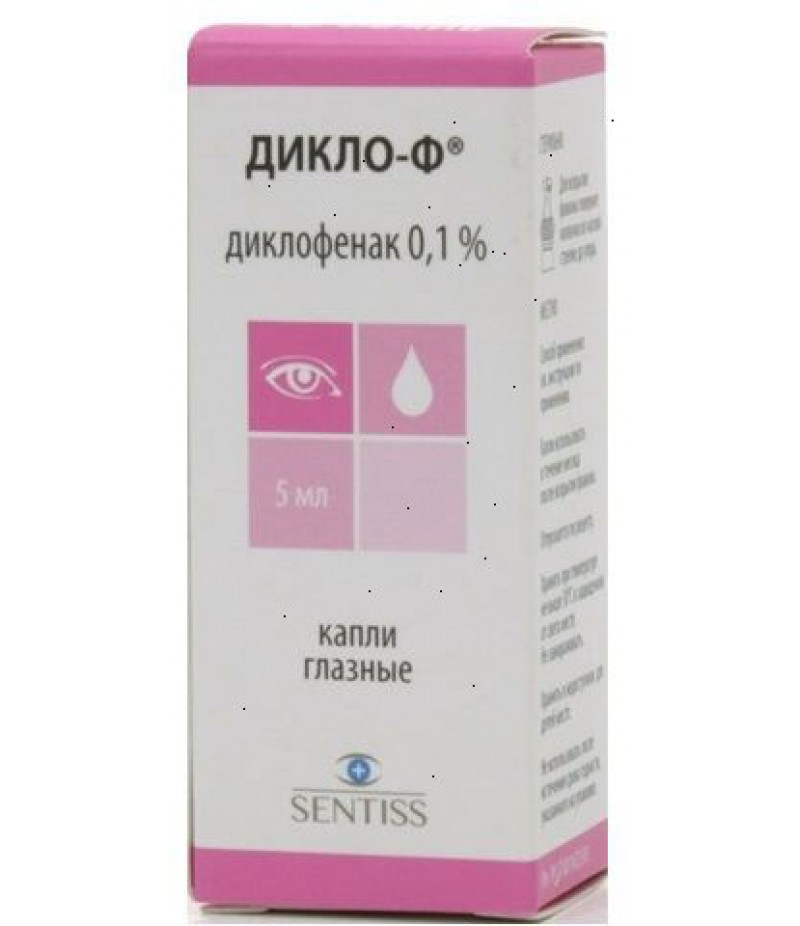Diclofenac eye drops 0.1% 5ml
- $5.60
- 3 or more $5.48
- Availability:In Stock
Diclofenac eye drops instruction for useTo buy eye drops Diclofenac, just add it to your shopping cartForm of formulation and composition of the preparationDiclofenac 0.1% is available in the form of drops for instillation in the ..
Tags: drops
Diclofenac eye drops instruction for use
To buy eye drops Diclofenac, just add it to your shopping cart
Form of formulation and composition of the preparation
Diclofenac 0.1% is available in the form of drops for instillation in the eyes, in vials of polymer material, equipped with a special dropper at the end. The volume of the bottle is 5 ml, the contents of which are sterile. The drug is packed in a cardboard box with the attached detailed description.
Eye drops of transparent color with a slightly yellowish tinge, without any inclusions, flakes or suspensions. The main active ingredient of the drug is diclofenac sodium (1 mg of the drug contains 1 mg of active ingredient), as the auxiliary components are: purified water, castor oil, disodium edetate, 1M solution, benzalkonium chloride.
Pharmacological properties of the drug
Eye drops Diclofenac belong to the group of non-steroidal anti-inflammatory drugs. Used in ophthalmology for the treatment of inflammatory diseases of the eyeball and eye mucosa. The active substance drops quickly removes the edema, eliminates the inflammatory process and has a pronounced analgesic effect.
Indications for use
The main indications for the use of Diclofenac in the form of 0.1% eye drops are the following conditions:
As a preventive agent for surgical interventions on the eyes, in particular when removing cataracts;
Treatment of inflammatory processes of the eyeball and eye mucosa against the background of ingress of a foreign body, trauma to the eye or surgical interventions;
As a prophylaxis and treatment of cystic macular edema of the retina after surgical removal of cataracts;
Fear of light against the background of the transferred keratomy;
Treatment of inflammatory pathologies of non-infectious eye - conjunctivitis, keratitis, dacryocystitis, erosive processes of the cornea.
Contraindications for Diclofenac eye drops
Eye drops Diclofenac can be used only after consultation with an ophthalmologist. Before instillation of the drug, the patient must carefully read the attached instructions, since Diclofenac Drop has a number of contraindications to use. Such states include:
Individual intolerance to the components of the drug;
Pregnancy in the first trimester;
Violations of the coagulated system of blood.
With special care, the drug is prescribed for children under 12 years and patients of retirement age.
Method of administration and dosage
Diclofenac 0.1% is for use in ophthalmic practice. The dose of the drug and the duration of the course of treatment should be determined by the doctor individually, depending on the characteristics of the patient's body, the diagnosis, the severity of the symptoms of the disease. According to the instructions, drops are prescribed 1-2 per conjunctival sac up to 5 times a day.
After the surgery on the eyes in order to prevent the development of the inflammatory process, the drug is instilled in the eye every hour, for 5 hours. The next day they switch to the usual dosage regimen.
Use of the drug in the form of eye drops in pediatric practice must always be agreed with the doctor. As a rule, children try to find an analogue of the drug.
The duration of the course of therapy may vary depending on the diagnosis, however, according to the description of the drug, eye drops are not recommended for use for more than 3-4 weeks. In the absence of the expected therapeutic effect or with worsening of the patient's condition, you should consult an ophthalmologist again and undergo additional examinations.
Application during pregnancy and breastfeeding
The use of eye drops in the first trimester of pregnancy is not recommended for women. The use of this drug in the 2nd and 3rd trimesters of pregnancy is possible only after assessing the indicators of benefit to the mother and the potential hazard to the fetus. Treatment is carried out under the strict supervision of a specialist in the shortest possible time. During the therapy of the future mother should constantly monitor the status of the clinical picture of blood, in particular the number of platelets in the blood.
The use of drops of Diclofenac during breastfeeding is possible under the supervision of a doctor according to the indications.
Side effects
With proper use of drops in the eyes, patients rarely develop negative reactions. With individual hypersensitivity to the components of the drug or uncontrolled application, it is possible to develop local side effects:
A burning sensation in the eyes;
Fogging or blurred vision;
Sensation of foreign body in the eye;
Feeling tingling in the eye;
Reddening of the mucous membrane of the eyes.
All of the above-described side effects are not dangerous, go unaided and do not require withdrawal of treatment with the drug.
In very rare cases, it is possible to develop allergic reactions in the form of hives or Quincke edema.
An overdose of the drug
Since the drug in the form of eye drops acts locally, an overdose of Diclofenac is almost impossible, but in order to prevent the development of the above-described side effects, it is not recommended to exceed the dose specified in the instruction or use the medication for more than 3-4 weeks.
Interaction of Diclofenac eye drops with other drugs
Eye drops Diclofenac is not recommended for use with anticoagulants or non-steroidal anti-inflammatory drugs, either topical or oral. In this case, the risk of side effects increases.
Eye drops Diclofenac can be used concomitantly with other preparations for instillation into the eye, as well as simultaneously with hormonal eye drops. In this case, the interval between instillation of different drugs should be at least 5 minutes.
special instructions
When using eye drops Diclofenac patients wearing contact lenses, they should be removed, instilled the drug and only after 15 minutes inserted back.
In the presence of purulent discharge in the eye or crusts in the roots of the eyelashes, before using the drug, it is recommended that the patient is first washed with an antiseptic solution using a sterile cotton swab. For each eye, you need to take a new swab, moving from the outer corner of the eye to the inner one.
Since with the instillation of the drug in the eyes, patients may have a somewhat impaired vision, during the period of therapy it is not recommended to drive or complex mechanisms that require clear and rapid action. Eye drops do not inhibit the work of the central nervous system.
With caution, the drug should be used in patients prone to bronchospasm or with bronchial asthma, as this can lead to aggravation of the general condition.
Conditions of dispensing and storage of the drug
To buy eye drops Diclofenac you don't need a prescription. The sealed bottle should be stored at a temperature of not more than 20 degrees in the original packaging away from children. The printed vial should be stored in the refrigerator for no more than 30 days from the time of opening and then discarded. The shelf life of the drug is indicated on the package, at the end of which the drops are to be disposed of.
If there is a turbidity in the vial or a suspension, the medicine should not be used!


